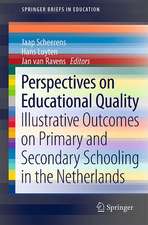Higher Education in the BRICS Countries: Investigating the Pact between Higher Education and Society: Higher Education Dynamics, cartea 44
Editat de Simon Schwartzman, Rómulo Pinheiro, Pundy Pillayen Limba Engleză Hardback – apr 2015
| Toate formatele și edițiile | Preț | Express |
|---|---|---|
| Paperback (1) | 650.86 lei 6-8 săpt. | |
| SPRINGER NETHERLANDS – 9 oct 2016 | 650.86 lei 6-8 săpt. | |
| Hardback (1) | 657.39 lei 6-8 săpt. | |
| SPRINGER NETHERLANDS – apr 2015 | 657.39 lei 6-8 săpt. |
Din seria Higher Education Dynamics
- 15%
 Preț: 648.24 lei
Preț: 648.24 lei - 15%
 Preț: 650.69 lei
Preț: 650.69 lei - 18%
 Preț: 957.62 lei
Preț: 957.62 lei - 18%
 Preț: 949.73 lei
Preț: 949.73 lei - 18%
 Preț: 897.65 lei
Preț: 897.65 lei - 15%
 Preț: 639.73 lei
Preț: 639.73 lei - 15%
 Preț: 648.56 lei
Preț: 648.56 lei - 15%
 Preț: 644.95 lei
Preț: 644.95 lei - 15%
 Preț: 641.85 lei
Preț: 641.85 lei - 15%
 Preț: 636.63 lei
Preț: 636.63 lei - 15%
 Preț: 644.18 lei
Preț: 644.18 lei - 18%
 Preț: 945.92 lei
Preț: 945.92 lei - 15%
 Preț: 640.55 lei
Preț: 640.55 lei - 15%
 Preț: 646.30 lei
Preț: 646.30 lei - 15%
 Preț: 644.63 lei
Preț: 644.63 lei - 15%
 Preț: 644.82 lei
Preț: 644.82 lei - 18%
 Preț: 946.24 lei
Preț: 946.24 lei - 15%
 Preț: 645.79 lei
Preț: 645.79 lei - 15%
 Preț: 645.79 lei
Preț: 645.79 lei - 15%
 Preț: 642.18 lei
Preț: 642.18 lei - 15%
 Preț: 645.79 lei
Preț: 645.79 lei - 15%
 Preț: 639.73 lei
Preț: 639.73 lei - 18%
 Preț: 952.26 lei
Preț: 952.26 lei - 18%
 Preț: 945.79 lei
Preț: 945.79 lei - 15%
 Preț: 643.65 lei
Preț: 643.65 lei - 15%
 Preț: 641.20 lei
Preț: 641.20 lei - 15%
 Preț: 638.11 lei
Preț: 638.11 lei - 15%
 Preț: 643.16 lei
Preț: 643.16 lei
Preț: 657.39 lei
Preț vechi: 773.41 lei
-15% Nou
Puncte Express: 986
Preț estimativ în valută:
125.79€ • 131.67$ • 104.70£
125.79€ • 131.67$ • 104.70£
Carte tipărită la comandă
Livrare economică 01-15 aprilie
Preluare comenzi: 021 569.72.76
Specificații
ISBN-13: 9789401795692
ISBN-10: 940179569X
Pagini: 492
Ilustrații: XVI, 493 p. 60 illus.
Dimensiuni: 155 x 235 x 32 mm
Greutate: 0.89 kg
Ediția:2015
Editura: SPRINGER NETHERLANDS
Colecția Springer
Seria Higher Education Dynamics
Locul publicării:Dordrecht, Netherlands
ISBN-10: 940179569X
Pagini: 492
Ilustrații: XVI, 493 p. 60 illus.
Dimensiuni: 155 x 235 x 32 mm
Greutate: 0.89 kg
Ediția:2015
Editura: SPRINGER NETHERLANDS
Colecția Springer
Seria Higher Education Dynamics
Locul publicării:Dordrecht, Netherlands
Public țintă
ResearchCuprins
Introduction.- The Rise of the BRICS and Higher Education Dynamics. Simon Schwartzman, Rómulo Pinheiro and Pundy Pillay.- Part I: Thematic Summaries.- Demand and Policies for Higher Education. Simon Schwartzman.- The Role of Internal and External Stakeholders. Rómulo Pinheiro.- Linking University Research and Innovation in the BRICS. Creso M. Sá.- Part II: Supply and Demand.- Demand and Supply for Higher Education in Brazil. Clarissa E. B. Neves.- Supply and Demand Patterns in Russian Higher Education. Isak Froumin and Yarolslav Kuuzminov.- Higher Education, Social Demand and Social Equity in India. Kishore M. Joshi.- Demands and Responses in Chinese Higher Education. Yuzhuo Cai and Fengqiao Yan.-Supply and Demand in South Africa. Kirti Menon.-Part III: The Role of Stakeholders.- The Role of Internal and External Stakeholders in Brazilian Higher Education. Elizabeth Balbachevsky.- Russian System of Higher Education and its Stakeholders: Ten years on the way to congruence. Evgeny Kniazev and Drantusova Natalya.- Cost Sharing in China’s Higher Education: Analyses of Major Stakeholders. Rui Yang.- The Role of Stakeholders in the Transformation of the South African Higher Education System. Peliwe Lolwana.- Part IV: Government Policy.- Higher Education policies in Brazil: A Case of Failure in Market Regulation. Maria H. M. Castro.- The Federal State, Regional Interests and the Reinvention of Russian Higher Education. Mark S. Johnson.- The Complex Web of Policy Choices: Dilemmas Facing Indian Higher Education Reform. Roopa D. Trilokekar and Sheila Embleton.- The Chinese Model of Development and the Higher Education Policy. Qiang Zha and Ruth Hayhoe.- State Power, Transition and New Modes of Coordination in Higher Education in South Africa. Michael Cross.- Part V: Research and Innovation.- Research and the ‘Third mission” in Light of Global Events. Creso M. Sá, Andrew Kretz and Kristjan Sigurdson.- Globalization and the Research Mission of Universities in Russia. Anna Smolentseva.- Research and Innovation in Indian Higher Education. Radhika Gorur and Fazal Rizvi.- Promoting Entrepreneurship and Innovation in China: Transformations in University Curriculum and Research Capacity. Joshua K. H. Mok and Kan Yue .- Research and Innovation in South Africa. Pundy Pillay.- EPILOGUE: Higher Education in the BRICS: What Have We Learnt and Where Are We Heading? Rómulo Pinheiro, Simon Schwartzman and Pundy Pillay.
Recenzii
“The book is highly recommended for scholars and students who major in or are interested in comparative education and higher education. Moreover, it should be of interest to policy makers and institutional leaders who want to benefit from the insights and policies of BRICS countries. The work of this volume marks an effective opening for future BRICS higher education studies.” (Shuhua Liu, Higher Education, Vol. 71, 2016)
Textul de pe ultima copertă
In spite of the increasing attention attributed to the rise in prominence of the BRICS (Brazil, Russia, India, China and South Africa) countries, few studies have looked at the ways in which broader social expectations with respect to the role of higher education across the BRICS have changed, or not, in recent years. Our point of departure is that, contrary to the conventional wisdom focusing on functionalistic perspectives, higher education systems are not just designed by governments to fulfill certain functions, but have a tendency for evolving in a rather unpredictable fashion as a result of the complex interplay between a number of internal and external factors. In reality, national higher education systems develop and change according to a complex process that encompasses the expectations of governmental agencies, markets, the aspirations of the population for the benefits of education, the specific institutional traditions and cultures of higher education institutions, and,increasingly so, the interests and strategies of the private firms entering and offering services in the higher education market. This basically means that it is of outmost importance to move away from conceiving of "universities" or "higher education" as single, monolithic actors or sector. One way of doing this is by investigating a selected number of distinct, but nonetheless interrelated factors or drivers, which, taken together, help determine the nature and scope of the social compact between higher education (its core actors and institutions) and society at large (government, industry, local communities, professional associations).
Caracteristici
First systematic comparative investigation of higher education developments across the BRICS region Pursues a novel approach by looking, in-depth, to a select number of key dimensions underpinning the role of higher education in society and economy Analyses the complex interplay between numerous internal and external factors impacting on higher education dynamics across the BRICS Provides unique empirical and conceptual insights of relevance to policy makers, institutional managers and social science researchers alike Includes supplementary material: sn.pub/extras













